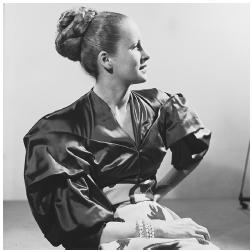Mad Carpentier - Fashion Designer Encyclopedia
American design house
Founded: by Mad Maltezos and Suzie Carpentier in Paris, 1939 (taking over from Vionnet after her retirement). Company History: House closed, 1957.
Publications
On MAD CARPENTIER:
Books
Perkins, Alice K., Paris Couturiers and Milliners, New York, 1949.
Picken, Mary Brooks, and Dora Loues Miller, Dressmakers of France: The Who, How and Why of the French Couture, New York, 1956.

Articles
"Carpentier Likes to Work with Folds," in WWD, 14 April 1948.
***
There were matters far more urgent in the late 1930s than that which led to the creation of the house of Mad Carpentier in January 1940. The firm's two partners—Mad Maltezos and Suzie Carpentier— banded together when Madeleine Vionnet, their former employer, closed in 1939.
In the unexamined cliché in fashion history and for a number of clients, the two women represented a continuation of Vionnet's bias cut and elegance in fashion combined with a discreet social model, always proper. Twins seized from a most inspired rib, two women balanced to equal one, and perseverance through the war years established an interesting mystique around Mad Carpentier. As Mary

Like Antoine de Saint-Exupéry heroines, Maltezos, designer and creative spirit, and Carpentier, refined and cordial proprietress, formerly a Vionnet vendeuse, sustained some of the ideas of Vionnet in soft evening clothes, but there were two special and autonomous distinctions for Mad Carpentier. In the late 1940s, Mad Carpentier created evening dresses of extraordinary historical fantasy, attenuating the body with faux bustles and creating the new sumptuousness of postwar evening clothes determined chiefly by silhouette. If these gowns did not achieve the flamboyant success of Fath and Dior in the same years, it is because the Mad Carpentier gowns are too redolent of the past and failed to capture the spirit of the "new" necessary to the marketing and imagination of the postwar era. Though Fath and Dior were both influenced by the past, the belle époque could scarcely be revived in this era without, at least, the veneer of the newest and most extravagant. A Mad Carpentier gown photographed in L'Officiel at Christmas in 1947 has New Look traits, but maintains the aura of a Victorian past.
Another hallmark of the house of Mad Carpentier were its remarkable coats, long surpassing the Vionnet tradition. The bravura shapes of Mad Carpentier coats in robust textures were immensely popular in the 1940s and 1950s independent of the Vionnet tradition. In particular, the coats were much imitated by Seventh Avenue, New York manufacturers, often rivaling the ever-popular Balenciaga coats for copying. B. Altman & Co., New York, for example, advertised a romantically sweeping long coat with high collar as "Mad Carpentier's famous coat…beautifully copied in all-wool fleece" in Vogue, January 1947. Amplitude, rugged materials, and the swaggering grandeur of riding coats gave both assertiveness and grace to the Mad Carpentier creations.
At Mad Carpentier, the Vionnet tradition was maintained in ease, a desire for easy shaping and even for tying. In the dresses, the full three-dimensionality emphasized by Vionnet was often compromised by an interest in details at the side, as if to reinstate planarity, but in the coats, the effect was to create soft, large volumes. Women's Wear Daily (14 April 1948) commented, "the firm has gone its quiet way, and now ranks as a house for clothes of distinctive character rather than one taking an active or publicized role in the general development of the Paris couture. Carpentier clothes have the handmade air of Vionnet, but do not always follow the bias technique of that school of dressmaking."
Linked to Vionnet's innovations in dressmaking, but in fact functioning with little inclination to their inventiveness, Mad Carpentier turned out to be a house of the most traditional dresses, genteel tailoring, and of sensational coats. Its understated, highly proper sensibility was at odds with advanced and aggressive postwar fashion and only in the exuberance of its sculptural coats did the imagination and reputation soar.
—Richard Martin
Comment about this article, ask questions, or add new information about this topic: